At first blush, Stockholm was a pleasant place to spend a week. I began in its medieval Old Town, known locally as Gamla Stan, where I visited the Royal Palace and Stortorget, the oldest square in Stockholm. I toured the spectacular City Hall. Built of eight million bricks, this remarkable building is the venue for the Nobel Peace Prizes each year. I toured free museums, ate picnic lunches in the city’s attractive parks, and took boat tours around the 14 islands that make up the city. But it was when I went underground that Stockholm morphed from pleasant to astonishing.
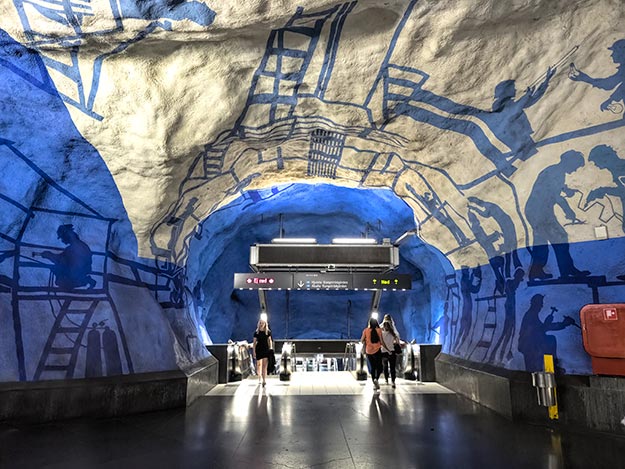
The three Metro lines beneath the Swedish capital stretch for 68 miles and include 100 stations. Nothing unusual about that. What is unusual is that more than ninety of these stations feature massive art installations. I began my exploration of art in the Stockholm Metro at T-Centralen, the system’s main hub. It was here that the idea to use the Stockholm subway to bring art to the public was born. I had to look hard to find art at T-Centralen’s ground level entrance. Eventually I spotted the trunk of a birch tree engraved on one of the glass panels, branches laden with oak leaves cascading down another, and a couple of hiking boots marching kitty-whompus up the glass.
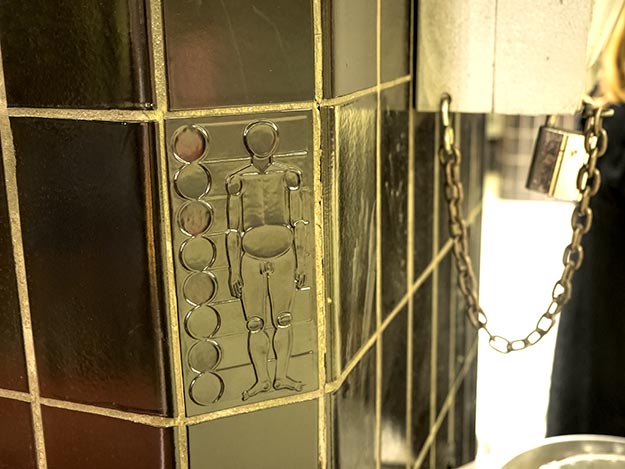
I rode the escalator down to the first level, where the art remained subtle. Rather than tear up the 1950 station, artists chose instead to add glass art tiles to the existing columns and walls. Further down, the subtlety disappeared and my eyes popped out of their sockets. With its striking blue on while silhouettes of workers, level two is an homage to the people who build the metro system. Carpenters, painters, and steelworkers march up the walls and across the ceiling. Continuing the white and blue motif, the walls and ceilings of level three’s cave-like station are criss-crossed by giant tractor tracks and Jack-in-the-Beanstalk vines.

Yet another level at T-Centralen features patterns on white tiles that resemble traffic signs. Even the moving walkways that carry passengers between stations at T-Centralen get into the act. Framed art photos and paintings line the walls next to the walkways.
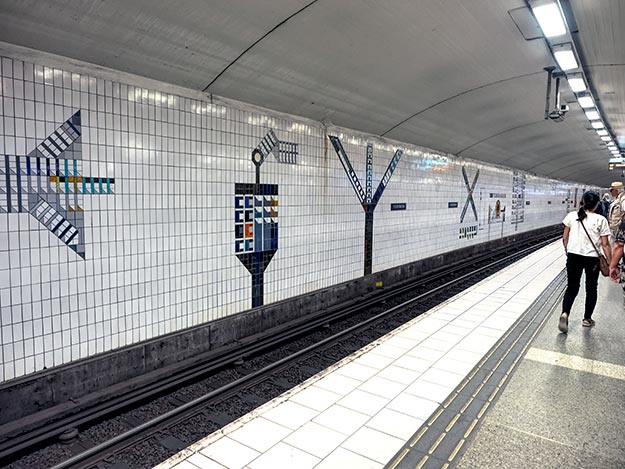
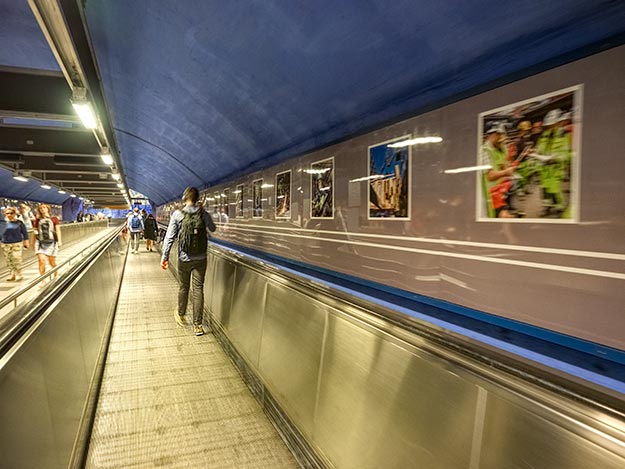
At Radhuset station, salmon colored walls reflect the colors found deep inside the Atlas Mountains of Morocco, while the giant wooden box hanging on the wall is a recreation of a Parm, an old farm instrument that was once used across Sweden to measure hay.

Around the corner, the artist recreated a giant stone pillar or chimney in honor of Sweden’s industrial history. And above, two boots – both left feet – hang upside-down from the ceiling. They represent the Shoe Store of Good Luck, which is located directly above the boots at street level.
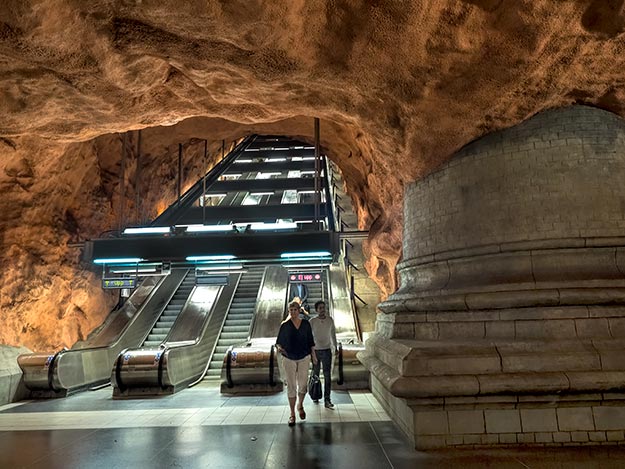
I rode to Fridhemsplan station, where a small Swedish sailing boat known as a blekingeeka is displayed in a glass case. Scattered around the station are other nautical artworks, including a large compass and an anchor chained to the wall.
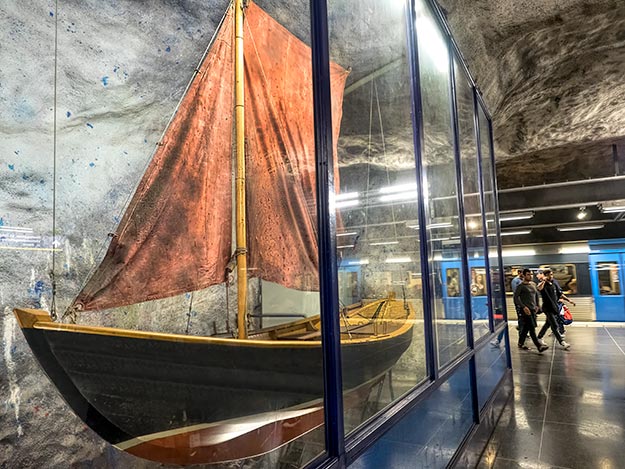
Another train, another station. Hortoget this time, where neon lights in six different shades scramble along the ceiling. The artist says the installation, which represents people rushing to work, was inspired by Madonna’s song, Ray of Light.
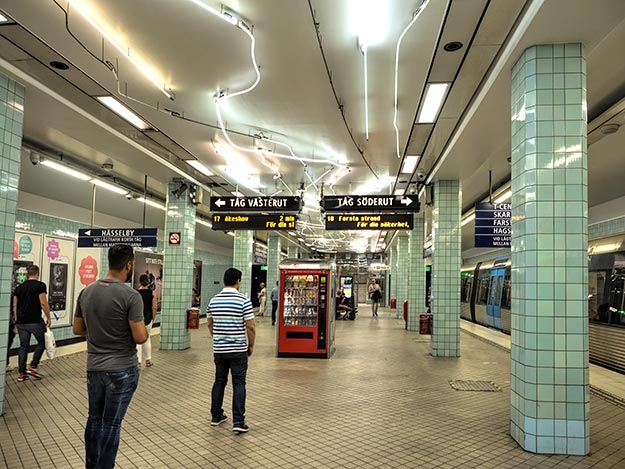
Next, I headed for Gamla Stan station, located in the heart of Stockholm’s Old Town. The floors are covered in geometric patterns that are reminiscent of buildings and waves, symbolizing the fact that Stockholm’s original settlement is located on an island surrounded by water.
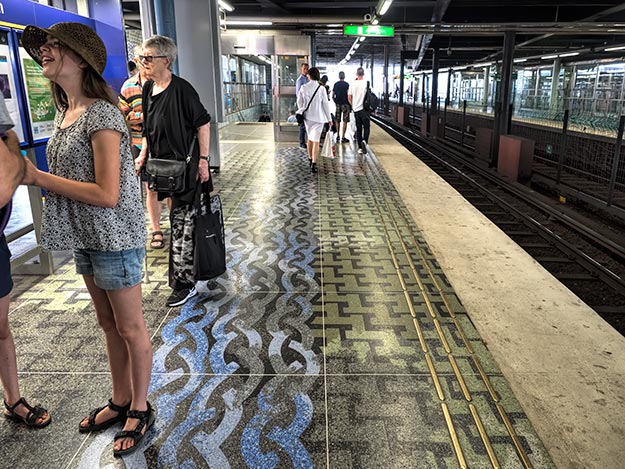
Poised at the end of the Gamla Stan platform, a large mural features circles that represent the halo effect that occurs when sun reflects off ice crystals. These same circles are included in the first painting of the city, which is currently displayed in the steeple of Old Town Cathedral.

Halfway into my tour I realized I was humming a tune by the Kingston Trio, The Man Who Never Returned. I had to laugh. The old folk ballad relates the story of a man named Charlie who got trapped in the Boston subway when the fare was suddenly increased and lacked enough money to get off the train.
Did he ever return? No he never returned!
And his fate is still unlearned,
He may ride forever ‘neath the streets of Boston,
He’s the man who never returned.
An hour and a half into my tour I had barely scratched the surface. I’d seen only five of the 90 stations that feature art installations. Like Charlie, it seemed I might ride forever ‘neath the streets of Stockholm.

Next up was Stadion station. Its blue-green cave celebrates the 1912 Olympics, which were held in a stadium near the station. Five bands of color span the ceiling, forming a startling rainbow that represents the five rings of the Olympic games.
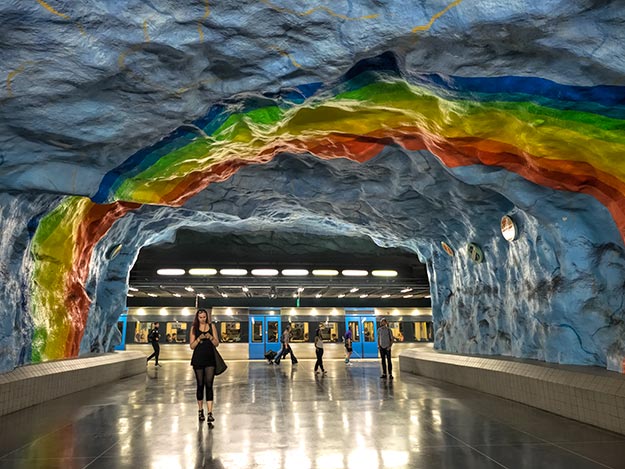
At Ostermalmstorg station, stylized charcoal sketches promoting the themes of women’s rights, peace, and the environmental movement have been sandblasted into white limestone walls.
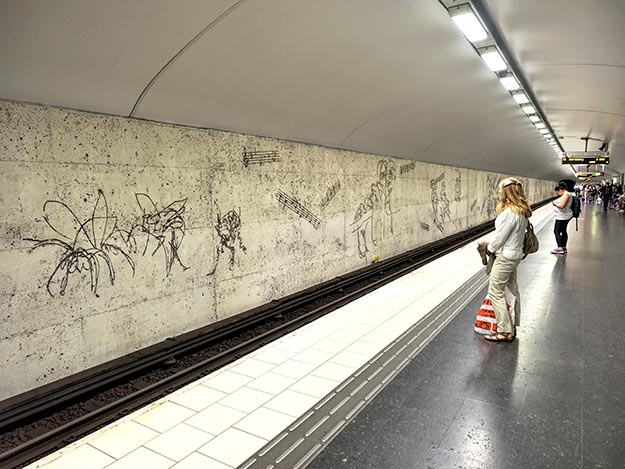
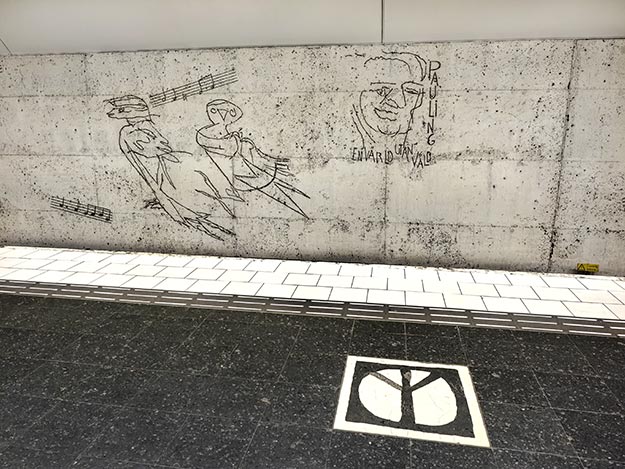
One section of Kungstradgarden station was awash in a red, green, and motif that screams of Venice. At the foot of another escalator the artist has created an underground garden in honor of the 17th-century Makalos palace, which stood for centuries in this Stockholm suburb until it burned down in 1825.


Back at T-Centralen, I had every intention of exiting the Metro, but another bank of escalators leading to the commuter trains grabbed my attention. Neon lights washed the metallic stairs in shades of peach, blue, and lilac.

I couldn’t resist riding down into the deepest bowels of the system, where a wide, hospital white corridor led to an ultra-modern station decorated with modern art and giant photos of Swedish street scenes.
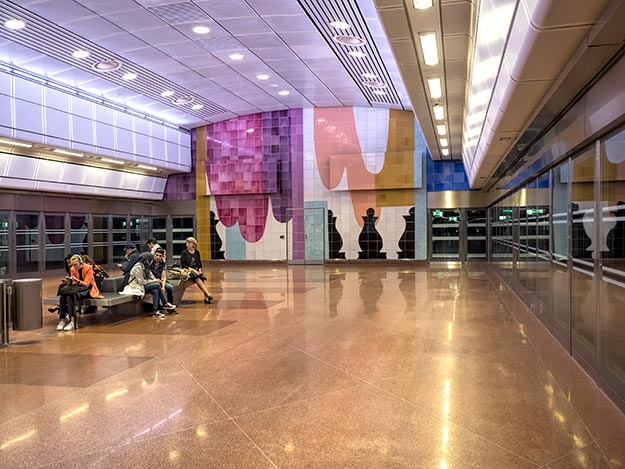
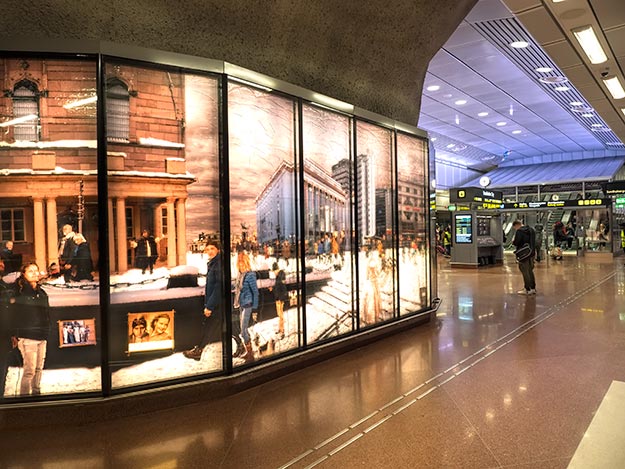
There was so much more to see, but I had only purchased a single-use ticket valid for 75 minutes and I was already well over my allowed time. Worried about being stopped by an inspector and fined, I finally made my way up five levels to the exit. Though I saw only a fraction of the art in the Stockholm Metro, there is no doubt in my mind that is the most fascinating thing about this delightful Scandinavian city.
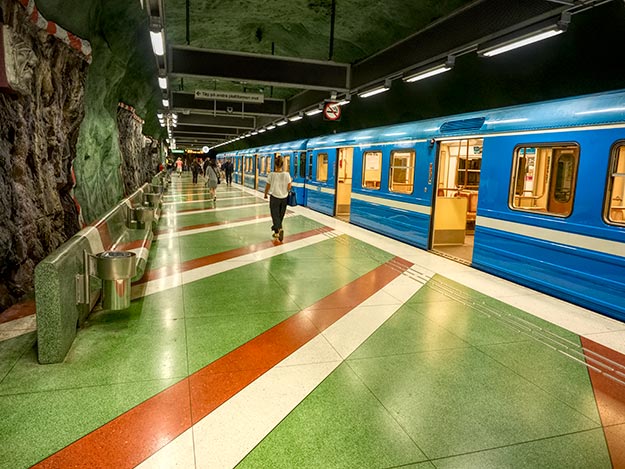
Author’s note: During the months of June, July, and August, Stockholm Metro conducts English-speaking guided art tours of four or five stations every Tuesday, Thursday and Saturday, at 3 p.m. The tours start from SL Center at T-Centralen Metro station (entrance from Sergels torg). The art walks take about an hour and are free, with the exception of the purchase of a metro ticket. A single-use ticket, good for 75 minutes, costs 30 Swedish Krona, or about $3.70 USD. But with so many stations to see, you may want to consider buying a 24-hour Travelcard for 120 SEK (slightly less than $15 USD).
Check prices for accommodations in Stockholm at Booking.com, Hotels.com, or HotelsCombined.com. Read reviews about hotels and guest houses in Stockholm, Sweden at TripAdvisor.
Disclosure: This article contains affiliate links to hotel booking sites. If you click on any of the links and make a booking, I may earn a small commission, which keeps this blog free to read.

Lovely photography. I lived on Södermalm in 2001/02. None of this artwork was installed at that time, so it is a pleasure to revisit my old haunts. My last visit was in 2013, but I spent most of my time visiting Viking sites, not commuting to and from work. You captured some of the enjoyment of finding little artifacts of the past in the modern architecture.
So glad you enjoyed it Gwen. Thanks for taking the time to comment.
Great blog shared. Love the art.
Thank you Alice! And I didn’t even see 50% of what’s down in the subway tunnels.
Although I’ve always appreciated street art, I recently developed a slight obsession and so I could easily see myself spending hours in the subways of Stockholm! Each station is unique and absolutely stunning!
Thanks Lydia – that was my exact impression. Wish I’d had more time to see all 90 stations.
Fabulous Barbara! This is my very first reading of your blog, introduced to me by my husband. We live near Boston and can definite relate to “Charlie on the MTA”. I SO wish Boston could learn from these talented Swedes! Looking forward to many more readings of your blog. Do you podcast any travel adventures?
Hi Vicki: Thanks for your lovely comment. I always love hearing from people who actually READ what I write. And I’m tickled that you’re from Boston and could really relate to my “Charlie” connection. Unfortunately, I don’t do any of my own podcasts. I’ve been featured in quite a few done by others, but I have so many irons in the fire that I just can’t add yet another element.
This is a great post! I’m thinking of adding Sweden to my next itinerary and you’ve increased my interest in going there.
Are the cave-like walls of the stations real or are they part of the decoration? They surely appear to be real but I’ve never seen an “unfinished” subway tunnel anywhere.
Libbie
Hi Libbie: I took the tour provided by the Metro system, which took us to five stations, then continued to others on my own. The cave-like stations that I visited with the guide were, according to her, all created. I have to assume that all of them would be the same.
I’ve never been to Sweden and did not know about their artful underground system. A definite must-see! Your article was intriguing and drew the reader into your sight-seeing venture. Thanks for a great read, Barbara!
Thanks Crystal. I was truly blown away by their subway system. I seriously could have kept riding around for hours more.
Thank you Barbara for bringing Sweden to life with your photos. We have never been there but it looks and feels fantastic from your blog. We feel inspired to visit.
Hi Linda: Your comment just made my day. If my stories can inspire people to travel, then I’m doing something right. Thanks for letting me know.